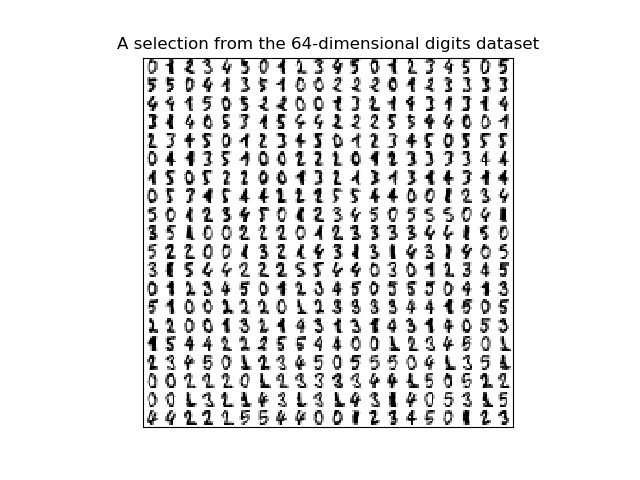sklearn.random_projection.SparseRandomProjection¶
class sklearn.random_projection.SparseRandomProjection(n_components='auto', *, density='auto', eps=0.1, dense_output=False, random_state=None)
[源码]
通过稀疏随机投影降低尺寸
稀疏随机矩阵是密集随机投影矩阵的替代,它可以保证相似的嵌入质量,同时具有更高的存储效率并可以更快地计算投影数据。
如果我们注意到s = 1 /密度,则随机矩阵的分量来自:
-sqrt(s)/ sqrt(n_components)的概率为1 / 2s 0,概率为1-1 / s sqrt / sqrt(n_components)的概率为1 / 2s
在用户指南阅读更多内容。
版本0.13中的新功能。
| 参数 | 说明 |
|---|---|
| n_components | int or ‘auto’, optional (default = ‘auto’) 目标投影空间的尺寸。 n_components可以根据数据集中的样本数和Johnson-Lindenstrauss引理给出的边界自动调整。 在那种情况下,嵌入的质量由eps参数控制。 应当指出,Johnson-Lindenstrauss引理可以对所需的组件数进行非常保守的估计,因为它无需对数据集的结构进行假设。 |
| density | 如果density ='auto',则将其设置为Ping Li等人建议的最小密度:1 / sqrt(n_features)。 如果要重现Achlioptas,2001的结果,请使用density = 1 / 3.0。 |
| eps | strictly positive float, optional, (default=0.1) 当n_components设置为“ auto”时,根据Johnson-Lindenstrauss引理控制嵌入质量的参数。 较小的值导致在目标投影空间中更好的嵌入和更多的尺寸(n_components)。 |
| dense_output | boolean, optional (default=False) 如果为True,则即使输入矩阵和随机投影矩阵都很稀疏,也要确保随机投影的输出是密集的numpy数组。 实际上,如果组件数量少,则投影数据中零组件的数量将非常小,并且使用密集表示将提高CPU和内存的效率。 如果为False,则在输入稀疏的情况下,投影数据将使用稀疏表示。 |
| random_state | int, RandomState instance or None, optional (default=None) 控制用于在拟合时间生成投影矩阵的伪随机数生成器。 为多个函数调用传递可重复输出的int值。 请参阅词汇表。 |
| 属性 | 说明 |
|---|---|
| n_components_ | int 当n_components =“ auto”时计算的具体组件数。 |
| components_ | CSR matrix with shape [n_components, n_features] 用于投影的随机矩阵。 |
| density_ | float in range 0.0 - 1.0 从密度=“自动”时计算的混凝土密度。 |
另见:
参考资料
1 Ping Li, T. Hastie and K. W. Church, 2006, “Very Sparse Random Projections”. https://web.stanford.edu/~hastie/Papers/Ping/KDD06_rp.pdf
2 D. Achlioptas, 2001, “Database-friendly random projections”, https://users.soe.ucsc.edu/~optas/papers/jl.pdf
示例
>>> from sklearn.random_projection import SparseRandomProjection
>>> rng = np.random.RandomState(42)
>>> X = rng.rand(100, 10000)
>>> transformer = SparseRandomProjection(random_state=rng)
>>> X_new = transformer.fit_transform(X)
>>> X_new.shape
(100, 3947)
>>> # very few components are non-zero
>>> np.mean(transformer.components_ != 0)
0.0100...
方法
| 方法 | 说明 |
|---|---|
fit(X[, y]) |
生成稀疏随机投影矩阵 |
fit_transform(X[, y]) |
适合数据,然后对其进行转换 |
get_params([deep]) |
获取此估计量的参数。 |
set_params(**params) |
设置此估算器的参数。 |
transform(X) |
通过将矩阵乘积与随机矩阵一起使用来投影数据 |
__init__(n_components='auto', *, density='auto', eps=0.1, dense_output=False, random_state=None)
[源码]
初始化self, 请参阅help(type(self))以获得准确的说明
fit(X, y=None)
[源码]
生成稀疏随机投影矩阵
| 参数 | 说明 |
|---|---|
| X | numpy array or scipy.sparse of shape [n_samples, n_features] 训练集:根据上述论文中引用的理论,仅使用形状来找到最佳随机矩阵尺寸。 |
| y | 被忽略 |
| 返回值 |
|---|
| self |
fit_transform(X, y=None, **fit_params)
[源码]
适合数据,然后对其进行转换。
使用可选参数fit_params将转换器拟合到X和y,并返回X的转换版本。
| 参数 | 说明 |
|---|---|
| X | {array-like, sparse matrix, dataframe} of shape (n_samples, n_features) |
| y | ndarray of shape (n_samples,), default=None 目标值。 |
| **fit_params | dict 其他拟合参数。 |
| 返回值 | 说明 |
|---|---|
| X_new | ndarray array of shape (n_samples, n_features_new) 转换后的数组。 |
get_params(deep=True)
[源码]
获取此估计量的参数
| 参数 | 说明 |
|---|---|
| deep | bool, default=True 如果为True,则将返回此估算器和作为估算器的包含子对象的参数。 |
| 返回值 | 说明 |
|---|---|
| params | mapping of string to any 参数名称映射到其值。 |
set_params(**params)
[源码]
设置此估算器的参数。
该方法适用于简单的估计器以及嵌套对象(例如管道)。 后者的参数格式为<component> __ <parameter>,以便可以更新嵌套对象的每个组件。
| 参数 | 说明 |
|---|---|
| **params | dict 估算器参数。 |
| 返回值 | 说明 |
|---|---|
| self | object 估算器实例。 |
transform(X)
[源码]
通过将矩阵乘积与随机矩阵一起使用来投影数据
| 参数 | 说明 |
|---|---|
| X | numpy array or scipy.sparse of shape [n_samples, n_features] 输入数据投影到较小的维空间中。 |
| 返回值 | 说明 |
|---|---|
| X_new | numpy array or scipy sparse of shape [n_samples, n_components] 投影阵列。 |






